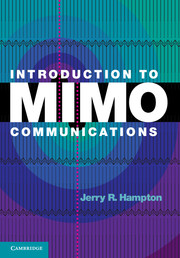Book contents
- Frontmatter
- Contents
- Preface
- 1 Overview of MIMO communications
- 2 The MIMO capacity formula
- 3 Applications of the MIMO capacity formula
- 4 RF propagation
- 5 MIMO channel models
- 6 Alamouti coding
- 7 Space-time coding
- 8 Spatial multiplexing
- 9 Broadband MIMO
- 10 Channel estimation
- 11 Practical MIMO examples
- Appendices
- References
- Index
2 - The MIMO capacity formula
Published online by Cambridge University Press: 05 December 2013
- Frontmatter
- Contents
- Preface
- 1 Overview of MIMO communications
- 2 The MIMO capacity formula
- 3 Applications of the MIMO capacity formula
- 4 RF propagation
- 5 MIMO channel models
- 6 Alamouti coding
- 7 Space-time coding
- 8 Spatial multiplexing
- 9 Broadband MIMO
- 10 Channel estimation
- 11 Practical MIMO examples
- Appendices
- References
- Index
Summary
In 1948 Claude Shannon published his famous paper titled “A mathematical theory of communications,” which was published in the July and October 1948 issues of the Bell Technical Journal [65, 66]. In that paper, he presented the fundamental concepts of what would later become the field of information theory, and derived mathematical expressions for the maximum theoretical data rate that could be transmitted over a communication system without errors. This maximum data rate, called the communications capacity, was derived for a conventional SISO system; however, the concepts he introduced in his landmark paper provided the framework for generalizing to MIMO systems. In 1999 Emre Telatar derived an expression for the theoretical capacity of a MIMO system using the concepts from information theory first developed by Shannon half a century earlier [70]. This chapter derives the MIMO capacity formula based on Telatar's arguments. The expression we develop in this chapter will be used to quantify the throughput enhancement that is possible with spatial multiplexing, as well as to provide a useful way of conceptualizing how MIMO systems work.
What is information?
In its most fundamental sense, the capacity of a communication system is defined as the maximum amount of information that can be conveyed per unit of time between two points over a communications channel. I assume that readers are familiar with digital communication techniques and that they have had a formal course (or its equivalent) in digital signal processing; however, I do not assume readers are familiar with information theory or are proficient in advanced matrix mathematics, areas of expertise that are normally assumed in the MIMO literature and in many of the books that have been published on this topic. When knowledge in these areas is required to understand MIMO concepts, I have attempted to include the necessary information on those topics in the book so that it is not necessary to consult external resources. In this sense, the book has been designed to be as self-contained as possible.
- Type
- Chapter
- Information
- Introduction to MIMO Communications , pp. 28 - 41Publisher: Cambridge University PressPrint publication year: 2013



